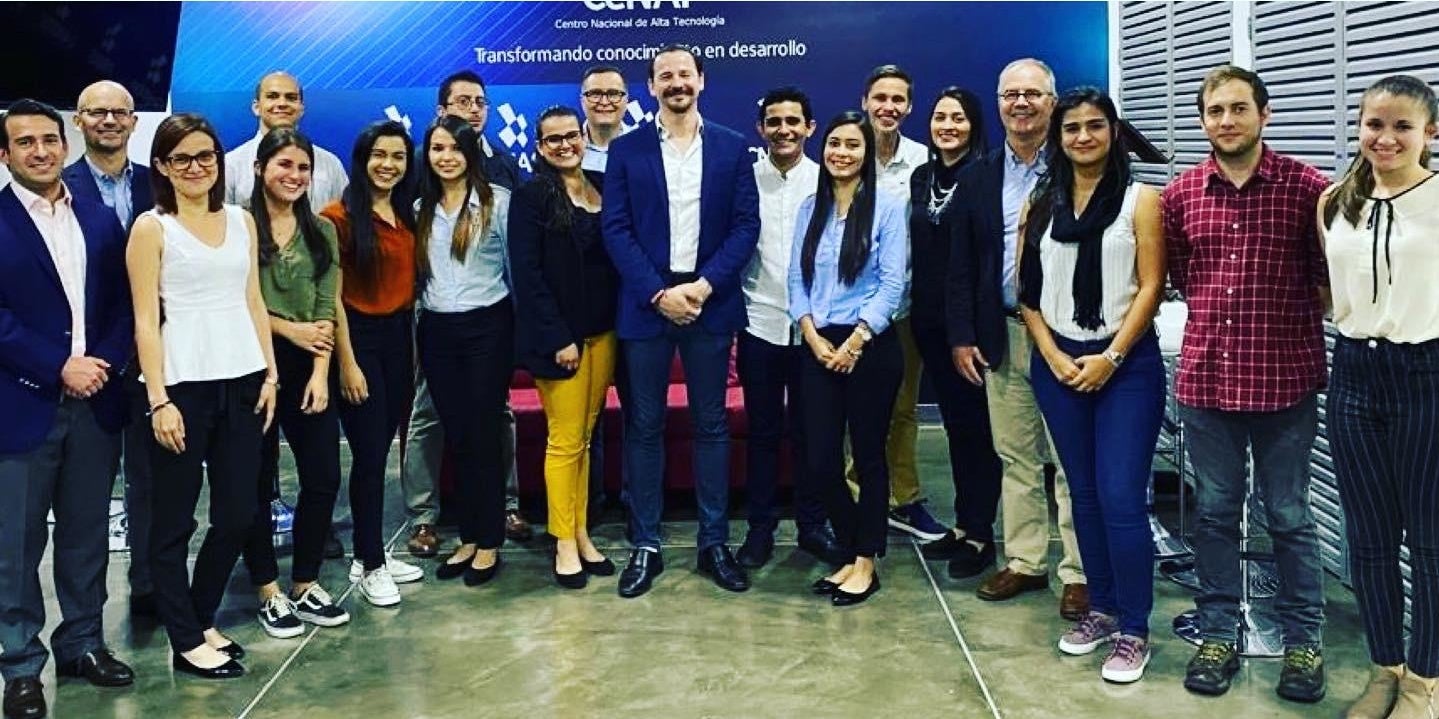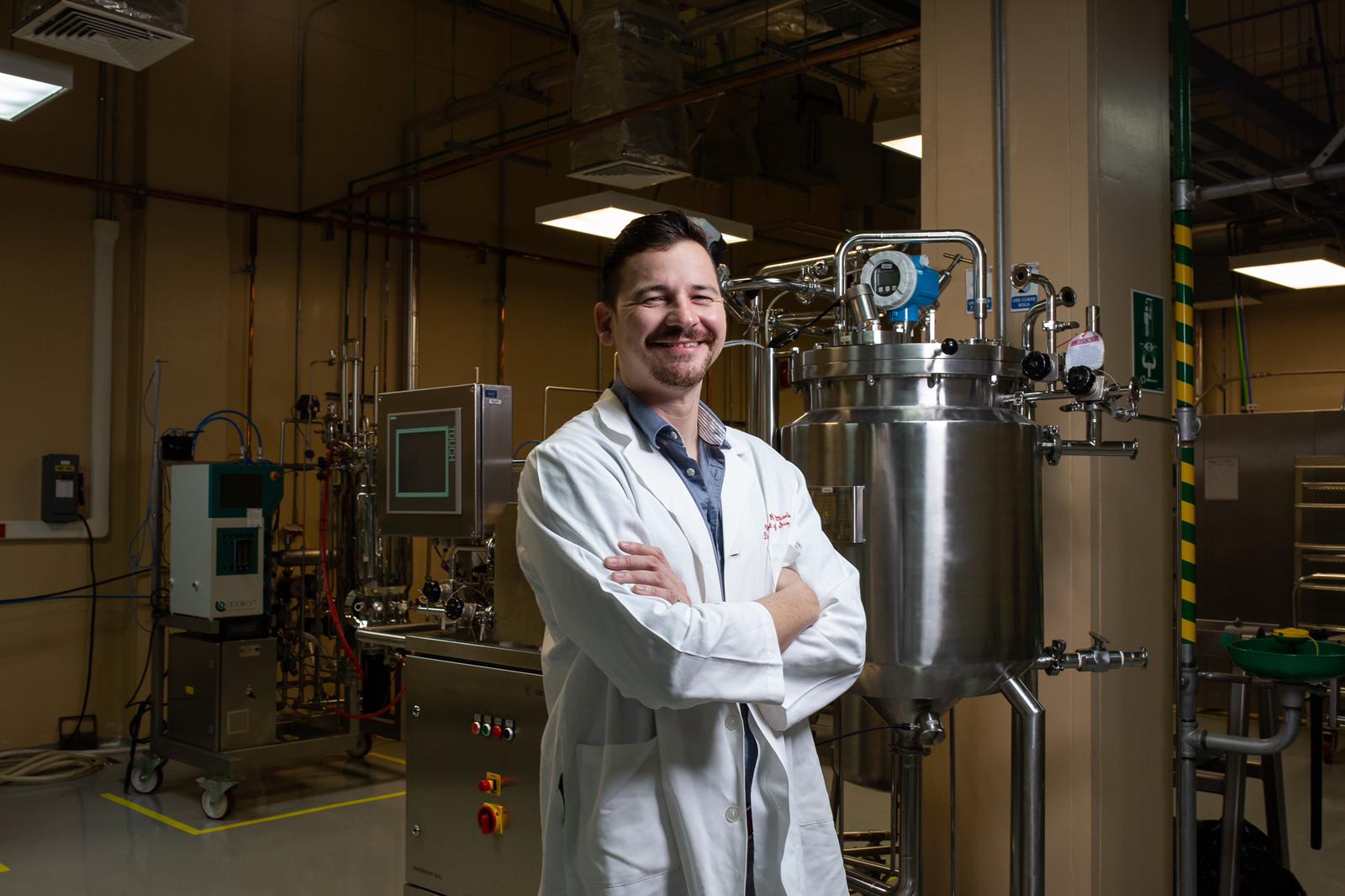Central America Leadership Initiative Fellow, Christian Marin Muller, specializes in virology. His company, Speratum, is working together with Roche Pharmaceuticals to adapt the innovative technology they developed for cancer treatment as a possible alternative treatment for COVID-19. This project utilizes synthetic biology and nanotechnology to direct molecules into infected cells in order to attack the virus. If proven effective, it would be a huge medical breakthrough for the world, and especially Costa Rica. Christian shares with us his work, Fellowship experience, and motivations that push him further, even during a global pandemic.
What draws you to healthcare innovation?
I am a Costa Rican. I was born and raised in Costa Rica, but traveled quite a bit with my parents for several years. While working towards my master’s degree, I started a small business and I got to learn a little bit about bootstrapping and working with low capital. After that, I decided to get my doctorate in molecular biology and microbiology from Baylor College of Medicine in Houston and started working there in the laboratory of Kathy Yow; she was working with both HIV and pancreatic cancer. My primary focus, however, was on pancreatic cancer and the mechanisms that give rise to pancreatic cancer. So we started working with an area of technology called RNA interference, which is a very promising area for therapeutics.
What has the impact of COVID-19 been like in Costa Rica?
Latin America is now becoming the epicenter of the pandemic and that’s going to be very difficult. The poverty that is being faced, the devastation, and loss of human lives as a result of this pandemic is going to be tragic. Here in Costa Rica, we’ve thankfully been very blessed with a health system that is well prepared to handle the crisis. Our Minister of Health is an epidemiologist, our director of our universal healthcare system is a biochemist. So they have been leading with science with every step of their decisions. That has allowed us to prepare very carefully and to really maximize the infrastructure that we have in the country. So the response has been fabulous and the citizens have had a very high level of social responsibility and social conscience.
But there’s also difficulties because not everyone can sustain multiple weeks of not going out to work. To combat this, the government has taken a very strategic approach at reopening. Our hospital system capacity could be overwhelmed in as little as three weeks, so it’s a matter of leadership in our community, a matter of communicating all the information to as many people as we can, and for people to have social responsibility. Hopefully here we can continue this trend and have a positive outcome.
What cancer treatment are you working toward right now?
We were working with one micro RNA that was a tumor suppressor in pancreatic cancer. Whenever it was missing, the tumor cells could grow more aggressively and rapidly and become resistant to chemotherapy more easily. So our idea was, ‘what if we can synthesize these molecules in the lab and then introduce them to the tumors, raise the levels and maybe put the brakes on cancer growth?’ We patented one micro RNA that works as a tumor suppressor in pancreatic and ovarian cancer, and hopefully multiple other cancer types as well.
The way that it works is we have to get these molecules, which have been structurally modified to get to tumors in order to raise the level and apply the brakes. For the past six years, we’ve been working to refine, optimize, and perfect these technologies and one of the great things is that we’ve now got everything to such a level that we’re basically pretty close to being able to enter clinical trials for our pancreatic cancer technology. This technology is not only useful for targeting molecules, with a simple redesign of the molecule that we’re inserting we can have them target just about anything that we want to target.
Image: Christian Marin Muller in his Laboratory.
What does this mean for COVID-19?
Coronavirus is an RNA virus, and it happens to have many sequences within its RNA that are targetable by our design. So we’ve now made several different candidates that we’re going to start testing to see if they potentially could work against the virus. We’re basically taking something that we’ve been developing for a long time and making it directly target specific cells in order to target specific molecules, and just reappropriating it to target the Covid-19 virus in virus-susceptible cells.
How is this approach different?
There’s a few different approaches that are being used. The latest statistics that I have seen from the Biotechnology Industry Organization, there are 615 different potential pharmacological interventions being developed between vaccines, antivirals, and different therapies, all using many different modalities. There are a few companies I know of that are working on RNA interference. But what sets us apart is that we have a fully integrated technology, have the delivery system, have the molecules, and hopefully we have the experience to be able to move this relatively quickly in a very effective and safe manner. But in the end, I hope that many of these treatments make it. The more options that we can have to treat this incredible thing that we’re all dealing with, the better it’s going to be for all of humanity. I hope that we get lots of vaccines, therapies and treatments that make it so that we can reach as many people as possible as quickly as we can.
Everyone is racing to find answers right now. What led you to take action?
We’ve always believed that this technology could be applied to multiple disease areas. It’s a very flexible and adaptable technology. As soon as we started seeing the impact that COVID-19 was going to have, we immediately started to think of where we could contribute. We also had to adapt to the situation because our lab was closed. It gave us some time to sit and think about direction, speed, and the most critical things to achieve in the near term.
And we are working now with the pharmaceutical company Roche.They’re giving us support to get this very first proof of concept stage off the ground. That’s been really great because it’s allowed us to take this first step without jeopardizing the rest of our project in time or in focus.
How is this collaboration done?
I think people who look at science from the outside sometimes forget that science is actually a very social endeavor. It requires a lot of networking, a lot of interactions. You’re constantly going to conferences, meeting people, discussing science, discussing papers. So over the years, I’ve been able to meet a lot of fantastic people from all over the world who are now helping me to connect with other people. It’s what Aspen does. A lot of the contacts that I have had that are helping me out on this project now have come from Aspen connections who have then, in turn, connected me with other people. And that’s what it’s all about. So right now, it’s about reaching out to all these connections and having conversations, discussions, presenting what we’re doing, and just finding what the best way is for us to reach our goal.

Image: Christian Marin Muller and his team.
How has your Central America Leadership Initiative Fellowship experience impacted your work?
Every time that I go on one of our Aspen seminars, I come back and basically take the seminar back to my company and my team. We try to have the Aspen mentality in everything that we do at Speratum. The name of our company means hope in Latin and it’s been the main influence on our company culture, our mission, and how we choose to apply the science that we work on.
This would be a major medical breakthrough coming out of Central America. What does that mean to you?
I think this could be incredibly big if we make it, of course we are very, very early in the process, so we have to make that caveat. But, if we manage to succeed in this endeavor, it will demonstrate that the talent is here. That was what brought me back to Costa Rica after being in the United States for more than 15 years. I returned to Costa Rica really just to explore the possibility of what could be done here and I found myself with a great pool of human talent. Costa Rica has not had an army for the past 50-60 years so all that money has gone towards education. We have a very fabulous education system here and a lot of very talented people, especially in biotech and science. Once I saw the human potential here and I saw the infrastructure that did exist, but was still being built up, it felt like it was an opportunity to demonstrate that something big could definitely be done here. And I think we’ve shown that we can, we have established the first Assessment and Accreditation of Laboratory Animal Care certified animal care and use program, the highest accrediting body for work in laboratory animals, and we were the first in Central America to have established this type of program. It shows that we can work at these high levels and that our work deserves to compete with anywhere else in the world.
What keeps you motivated?
For me and my team, our motivation is knowing that everything that we do, even when something goes wrong in an experiment, is just more knowledge that adds to us getting a step closer to fulfilling our mission of reaching patients. And this gives us another opportunity to showcase the potential of our technology to contribute to something that is, right now, the most critical thing in the planet as far as health goes. Hopefully, the fact that we’re doing this from Costa Rica will also be impactful by demonstrating that we have the capabilities here to do these kinds of innovations. We may not have all the resources or all the infrastructure, but we definitely have the basics that we need and we have collaborations to cover the rest of what we need.


